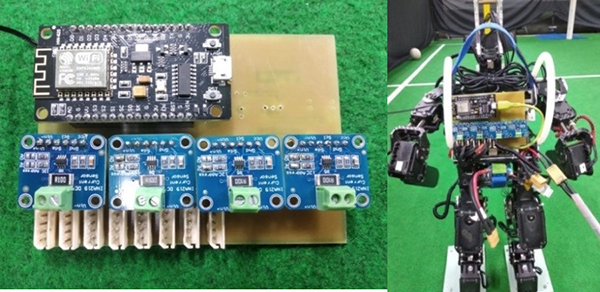Monitoring Power Usage on Humanoid Robot Wirelessly Using the INA219 Sensor
DOI:
https://doi.org/10.12928/biste.v3i1.3334Keywords:
Robot Humanoid, Monitoring Daya, Wireless, Tegangan Listrik, Arus ListrikAbstract
Currently, humanoid robot power measurements are only carried out when there is a robot's movement that is weakened or unable to move optimally. This is considered to be less than optimal in preventing damage/weakness of the robot's movement. The monitoring device is installed on each part of the humanoid robot, namely the hands and feet, then it will send the current and voltage results via the wireless system. The current sensor used is an INA219 type which is calibrated with a resistor. The power supply used is 12.6 V and the resistors for calibration are 15 Ohm, 18 Ohm, 22 Ohm, 39 Ohm, 47 Ohm, 56 Ohm with each resistor having a power resistance of 5W. The INA219 sensor can read the current, voltage, and power values of the resistor even though there are still differences when compared to multimeter measuring instruments. The results of sensor calibration with a resistor will be used as a comparison when monitoring the humanoid robot. NodeMCU ESP8266 as a microcontroller and wi-fi module. The web server can operate properly when there is a connection. Monitoring runs in real-time for 1 second to refresh data. In the results obtained in all tests, all INA219 sensors can work but are less accurate. For smooth wireless communication and in accordance with research objectives.References
A. I. Bardani and N. S. Widodo, “Deteksi Zona pada KRSTI dengan Sensor Warna TCS3200,” Buletin Ilmiah Sarjana Teknik Elektro, vol. 1, no. 2, pp. 56–63, 2019. https://doi.org/10.12928/biste.v1i2.955
A. S. Samosir and N. S. Widodo, “Gyroscope and Accelerometer Sensor on the Lanange Jagad Dance Robot Balance System,” Buletin Ilmiah Sarjana Teknik Elektro, vol. 2, no. 2, pp. 51–58, 2020. https://doi.org/10.12928/biste.v2i2.922
D. W. Suryawan, Sudjadi, and Karnoto, “Rancang Bangun Sistem Monitoring Tegangan, Arus Dan Temperatur Pada Sistem Pencatu Daya Listrik Di Teknik Elektro Berbasis Mikrokontroler Atmega 128,” Transient, vol. 1, no. 4, 2012. https://ejournal3.undip.ac.id/index.php/transient/article/view/1274
R. Fernando, I. P. D. Wibawa, and C. Ekaputri, “Sistem Kendali Dan Monitor Penggunaan Daya Listrik Pada Perangkat Listrik Rumah Berbasis IOT,” eProceeding of Engineering, vol. 15, no. 2, 2018. https://openlibrarypublications.telkomuniversity.ac.id/index.php/engineering/article/view/8234
M. Setiawan and R. D. Puriyanto, “Arduino-Based Battery Voltage Monitoring and SMS Gateway,” Buletin Ilmiah Sarjana Teknik Elektro. Vol. 2. No 3. pp. 111–118. 2020. https://doi.org/10.12928/biste.v2i3.1478
H. Yuliansyah, “Uji Kinerja Pengiriman Data Secara Wireless Menggunakan Modul ESP8266 Berbasis Rest Architecture,” Electrician Jurnal Rekayasa dan Teknologi Elektro, vol. 10, no. 2, 2016. https://electrician.unila.ac.id/index.php/ojs/article/view/217
A. Fitriandi, E. Komalasari, and H. Gusmedi, “Rancang Bangun Alat Monitoring Arus dan Tegangan Berbasis Mikrokontroler dengan SMS Gateway,” Jurnal Rekayasa Dan Teknologi Elektro, vol. 10, no. 2, 2016. https://electrician.unila.ac.id/index.php/ojs/article/view/215
R. I. Putra, Sunardi, and R. D. Puriyanto, “Pemantauan Tegangan Baterai Lithium Polymer pada Robot Line Follower secara Nirkabel,” Buletin Ilmiah Sarjana Teknik Elektro, vol. 1, no. 2, 2016. https://doi.org/10.12928/biste.v1i2.907
Winasis, A. W. W. Nugraha., I. Rosyadi, “Desain Sistem Monitoring Nirkabel Berbasis Website Untuk Pemantauan Baterai Dan Beban Pembangkit Listrik Hibrida Surya – Angin,” Jurnal Teknik Elektro-ITP. Vol. 5. No. 2. pp. 137–142. 2016. https://ejournal.itp.ac.id/index.php/telektro/article/view/296
A. Setiawan, D. Suryadi, and E. D. Marindani, “Catu Daya Digital Menggunakan LM2596 Berbasis Arduino Uno R3,” Jurnal Teknik Elektro Universitas Tanjungpura, vol. 1, no. 1, 2020. https://jurnal.untan.ac.id/index.php/jteuntan/article/view/39582
Utama, Aditya W. "Rancang Bangun Solar Tracker dengan Sensor Light Dependent Resistor Berbasis Arduino." Jurnal Citra Widya Edukasi, vol. 11, No. 2, pp. 101-118, 2019. http://journal.cwe.ac.id/index.php/jurnal_citrawidyaedukasi/article/view/192

Downloads
Published
How to Cite
Issue
Section
License
Copyright (c) 2021 Ibnu Fauzi

This work is licensed under a Creative Commons Attribution-ShareAlike 4.0 International License.
Authors who publish with this journal agree to the following terms:
- Authors retain copyright and grant the journal right of first publication with the work simultaneously licensed under a Creative Commons Attribution License that allows others to share the work with an acknowledgment of the work's authorship and initial publication in this journal.
- Authors are able to enter into separate, additional contractual arrangements for the non-exclusive distribution of the journal's published version of the work (e.g., post it to an institutional repository or publish it in a book), with an acknowledgment of its initial publication in this journal.
- Authors are permitted and encouraged to post their work online (e.g., in institutional repositories or on their website) prior to and during the submission process, as it can lead to productive exchanges, as well as earlier and greater citation of published work (See The Effect of Open Access).
This journal is licensed under a Creative Commons Attribution-ShareAlike 4.0 International License.


